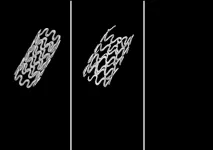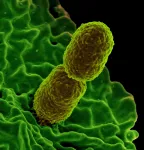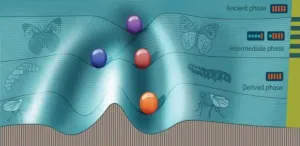Breathing easier with a better tracheal stent
Pitt researchers demonstrate first successful use of biodegradable magnesium-alloy stent for pediatric patients
2021-01-15
(Press-News.org) Pediatric laryngotracheal stenosis (LTS), a narrowing of the airway in children, is a complex medical condition. While it can be something a child is born with or caused by injury, the condition can result in a life-threatening emergency if untreated.
Treatment, however, is challenging. Depending on the severity, doctors will use a combination of endoscopic techniques, surgical repair, tracheostomy, or deployment of stents to hold the airway open and enable breathing.
While stents are great at holding the airway open and simultaneously allowing the trachea to continue growing, they can move around, or cause damage when they're eventually removed. New research published in Communications Biology and led by the University of Pittsburgh is poised to drastically improve the use of stents, demonstrating for the first time the successful use of a completely biodegradable magnesium-alloy tracheal stent that avoids some of these risks.
"Using commercial non-biodegradable metal or silicone based tracheal stents has a risk of severe complications and doesn't achieve optimal clinical outcomes, even in adults," said Prashant N. Kumta, Edward R. Weidlein Chair Professor of bioengineering at the Swanson School of Engineering. "Using advanced biomaterials could offer a less invasive, and more successful, treatment option."
In the study, the balloon-expandable ultra-high ductility (UHD) biodegradable magnesium stent was shown to perform better than current metallic non-biodegradable stents in use in both in lab testing and in rabbit models. The stent was shown to keep the airway open over time and have low degradation rates, displaying normal healing and no adverse problems.
"Our results are very promising for the use of this novel biodegradable, high ductility metal stent, particularly for pediatric patients," said Kumta, who also holds appointments in Chemical and Petroleum Engineering, Mechanical Engineering and Materials Science, and the McGowan Institute of Regenerative Medicine. "We hope this new approach leads to new and improved treatments for patients with this complex condition as well as other tracheal obstruction conditions including tracheal cancer."
INFORMATION:
The paper, "In-vivo efficacy of biodegradable ultrahigh ductility Mg-Li-Zn alloy tracheal stents for pediatric airway obstruction," (DOI: 10.1038/s42003-020-01400-7), was authored by the Swanson School's Jingyao Wu, Abhijit Roy, Bouen Lee, Youngjae Chun, William R. Wagner, and Prashant N. Kumta; UPMC's Leila Mady, Ali Mübin Aral, Toma Catalin, Humberto E. Trejo Bittar, and David Chi; and Feng Zheng and Ke Yang from The Institute of Metal Research at the Chinese Academy of Sciences.
[Attachments] See images for this press release:

ELSE PRESS RELEASES FROM THIS DATE:
2021-01-15
There is currently no cure for osteoarthritis, but a group of scientists believe they've discovered a method through which a simple knee injection could potentially stop the disease's effects. These researchers showed that they could target a specific protein pathway in mice, put it into overdrive and halt cartilage degeneration over time. Building on that finding, they were able to show that treating mice with surgery-inducedknee cartilage degeneration through the same pathway via the state of the art of nanomedicine could dramatically reduce the cartilage degeneration and knee pain. These findings were published in Science Translational Medicine.
"Our lab is one of the few in the world studying epidermal growth factor receptor (EGFR) ...
2021-01-15
The Gulf of Mexico holds huge untapped offshore oil deposits that could help power the U.S. for decades.
The energy super basin's longevity, whose giant offshore fields have reliably supplied consumers with oil and gas since the 1960s, is the result of a remarkable geologic past - a story that began 200 million years ago among the fragments of Pangea, when a narrow, shallow seaway grew into an ocean basin, while around it mountains rose then eroded away.
The processes that shaped the basin also deposited and preserved vast reserves of oil and gas, of which only a fraction has been extracted. Much of the remaining oil lies buried beneath ancient salt layers, just recently illuminated ...
2021-01-15
MADISON, Wis. -- The demand for COVID-19 vaccines continues to outpace supply, forcing public health officials to decide who should be first in line for a shot, even among those in the same pool of eligible vaccine recipients.
To assist these efforts, researchers at the University of Wisconsin School of Medicine and Public Health and UW Health have developed a tool that incorporates a person's age and socioeconomic status to prioritize vaccine distribution among people who otherwise share similar risks due to their jobs. The tool helps identify those who are at greater risk of severe ...
2021-01-15
WHAT:
Scientists studying the body's natural defenses against bacterial infection have identified a nutrient--taurine--that helps the gut recall prior infections and kill invading bacteria, such as Klebsiella pneumoniae (Kpn). The finding, published in the journal Cell by scientists from five institutes of the National Institutes of Health, could aid efforts seeking alternatives to antibiotics.
Scientists know that microbiota--the trillions of beneficial microbes living harmoniously inside our gut--can protect people from bacterial infections, but little is known about how they provide protection. Scientists are studying the microbiota with an eye to finding or enhancing natural treatments to replace antibiotics, which ...
2021-01-15
A new study, led by a theoretical physicist at the U.S. Department of Energy's Lawrence Berkeley National Laboratory (Berkeley Lab), suggests that never-before-observed particles called axions may be the source of unexplained, high-energy X-ray emissions surrounding a group of neutron stars.
First theorized in the 1970s as part of a solution to a fundamental particle physics problem, axions are expected to be produced at the core of stars, and to convert into particles of light, called photons, in the presence of a magnetic field.
Axions may also make up dark matter - the mysterious stuff that accounts for an estimated 85 percent of the total mass of the universe, yet we have so far only seen its gravitational effects on ordinary matter. Even if the X-ray excess turns out not to be ...
2021-01-15
Computer simulations of cells evolving over tens of thousands of generations reveal why some organisms retain a disused switch mechanism that turns on under severe stress, changing some of their characteristics. Maintaining this "hidden" switch is one means for organisms to maintain a high degree of gene expression stability under normal conditions.
Tomato hornworm larvae are green in warmer regions, making camouflage easier, but black in cooler temperatures so that they can absorb more sunlight. This phenomenon, found in some organisms, is called phenotypic switching. Normally hidden, this switching is activated in response to dangerous genetic or environmental changes.
Scientists have typically studied this ...
2021-01-15
Scientists at the Institute of Physics of the University of Tartu have found a way to develop optical quantum computers of a new type. Central to the discovery are rare earth ions that have certain characteristics and can act as quantum bits. These would give quantum computers ultrafast computation speed and better reliability compared to earlier solutions. The University of Tartu researchers Vladimir Hizhnyakov, Vadim Boltrushko, Helle Kaasik and Yurii Orlovskii published the results of their research in the scientific journal Optics Communications.
While in ordinary computers, the units of information are binary digits or bits, in quantum computers the units are quantum bits or qubits. In an ordinary computer, information is mostly ...
2021-01-15
Tsukuba, Japan - Out with the old, in with the new, as the New Year's saying goes, but not where the marine environment is concerned. Researchers from Japan have discovered that ocean acidification keeps algal communities locked in a simplified state of low biodiversity.
In a study published on 11th January 2021 in Global Change Biology, researchers from the University of Tsukuba have revealed that as oceanic carbon dioxide levels rise, the biodiversity and ecological complexity of marine algal communities decline.
Ocean acidification is the continuing increase in the acidity of the Earth's oceans, caused by the absorption of atmospheric carbon dioxide (CO2). ...
2021-01-15
The celebrations in the 250th anniversary of the birth of Ludwig van Beethoven would not be the same without Herbert von Karajan's brilliant performances conducting Beethoven's memorable symphonies. The execution of any musical symphony is a hugely difficult task, demanding very significant skills on the part of each individual musician - but perhaps the most difficult task lies with the conductor who has to orchestrate the musicians into making the music cohesively come alive and speak to our deepest emotions.
In many ways the human brain is like an orchestra, where different regions perform very different types of processing, such ...
2021-01-15
A new study conducted at the University of Turku, Finland, shows that patients with a schizophrenia spectrum disorder have an increased risk of Parkinson's disease later in life. The increased risk may be due to alterations in the brain's dopamine system caused by dopamine receptor antagonists or neurobiological effects of schizophrenia.
The record-based case-control study was carried out at the University of Turku in collaboration with the University of Eastern Finland. The study examined the occurrences of previously diagnosed psychotic disorders and schizophrenia in over 25,000 Finnish Parkinson's disease (PD) patients ...
LAST 30 PRESS RELEASES:
[Press-News.org] Breathing easier with a better tracheal stent
Pitt researchers demonstrate first successful use of biodegradable magnesium-alloy stent for pediatric patients






